ARCHIVED - Immigration and Refugee Board of Canada
 This page has been archived.
This page has been archived.
Archived Content
Information identified as archived on the Web is for reference, research or recordkeeping purposes. It has not been altered or updated after the date of archiving. Web pages that are archived on the Web are not subject to the Government of Canada Web Standards. As per the Communications Policy of the Government of Canada, you can request alternate formats on the "Contact Us" page.
2008-2009
Reports on Plans and Priorities
Immigration and Refugee Board of Canada
The Honourable Diane Finley
Minister of Citizenship and Immigration
Table of Contents
Section 1: OverviewSection 2: Analysis of Program Activities by Strategic Outcome
Section 3: Supplementary Information
Section 4: Other Items of Interest
Section 1: Overview
Message from the Chairperson

I am pleased to present the 2008-2009 Report on Plans and Priorities for the Immigration and Refugee Board of Canada (IRB).
The IRB is an independent administrative tribunal with unique and important responsibilities within Canada's immigration, refugee determination and administrative justice systems. The IRB deals with cases ranging from admissibility hearings and immigration appeals to refugee status determination and detention reviews. Through its work on behalf of Canadians, the IRB contributes directly to Canada's humanitarian traditions and the security of Canada.
The impact of IRB decisions on the lives of those who appear before its three divisions, as well as Canadians more generally, is profound. The sense of responsibility and service inherent in this work is shared by all IRB personnel. Canadians depend on the IRB to continue to carry out its mandate with the highest regard for integrity, fairness and efficiency.
Our operating environment
The IRB carries out its work in a complex environment, where shifting global migration patterns and refugee movements, among other factors, influence the number and type of cases the IRB receives. Over the coming year, the caseload is expected to grow in all three IRB divisions.
In addition, the considerable shortfall in the decision-maker complement in both the Refugee Protection Division (RPD) and the Immigration Appeal Division (IAD) will result in growing inventories for these divisions, which together will form the highest inventory in the IRB's history. Consequently, the IRB's ability to process cases will be significantly affected. Average processing times for refugee protection claims may reach 16.5 months and 11 months for immigration appeals. This is clearly too long. The key to reducing the pending inventories will be returning as quickly as possible to a full complement of decision-makers in the RPD and the IAD and determining at the earliest opportunity, while maintaining fairness, which refugee claims and immigration appeals are meritorious and which are not.
Continuing to transform the way we work
Over the past several years, the IRB has been actively pursuing a transformation agenda to ensure the consistent delivery of high-quality administrative justice within a changing environment. Although the IRB is already recognized as an innovative, expert tribunal, we are continually seeking new ways to improve the way we deliver our services.
To this end, we are further pursuing a number of initiatives to integrate our three divisions and ensure that all IRB personnel work together effectively. In this context, I would like to highlight the amendment to the IRB strategic outcome, which better reflects the contributions of our adjudicative support personnel in resolving cases brought before the IRB.
In the year ahead, we will continue to consolidate and extend the gains made in past years, with the objective of achieving further operational efficiencies and streamlining case resolution processes without compromising fairness.
Strategic direction and priorities of the IRB
Our strategic direction for 2008-2009 is to pursue our transformation agenda to create a flexible tribunal where the workforce is integrated, innovative and continues to fulfill the IRB's mandate. In supporting this direction, we will focus on the following three strategic priorities in 2008-2009. Together, these build on our priorities from the previous fiscal year.
- Manage the case inventory through innovative adjudicative and case management strategies.
- Further integrate the work of the IRB to promote effective management.
- Continue to build a flexible organization with clear accountabilities, ethical behaviour, leadership and operational capacity.
In line with these strategic priorities, we will focus on both new and ongoing initiatives in the year ahead. These include:
- Intensive decision-maker recruitment and selection efforts to ensure that the Government is provided with a sufficient pool of qualified candidates for appointment to the RPD and the IAD.
- Implementation of a plan to reform IRB governance, with a view to clarifying management responsibilities and accountabilities and improving the IRB's organizational design.
- Continued implementation of a comprehensive cross-divisional training program for decision-makers and tribunal officers.
- Development and implementation of adjudicative strategies in all three divisions to promote quality decision-making and improve consistency in approach to common issues, such as requests for postponements and adjournments.
- Further implementation of adjudicative support, including early resolution of cases and case readiness procedures across all divisions, to ensure that files are hearing-ready and to facilitate proactive hearings.
Looking ahead
In 2008-2009, we will continue to integrate our operations to become a more flexible organization and identify and implement new measures to improve the way we carry out the important mandate that Parliament has entrusted to the IRB. Key to our efforts will be the continued dedication of IRB personnel, whose professionalism, creativity and adaptability gives me every confidence in our success.
I invite you to read this report and to visit our Web site at www.irb-cisr.gc.ca for more information about the IRB and its plans and priorities for the coming year.
Brian Goodman
Chairperson
Management Representation Statement
I submit for tabling in Parliament the 2008-2009 Report on Plans and Priorities for the Immigration and Refugee Board of Canada.
This document has been prepared based on the reporting principles contained in the Guide to the Preparation of Part III of the 2008-2009 Estimates: Reports on Plans and Priorities and Departmental Performance Reports:
- it adheres to the specific reporting requirements outlined in the Treasury Board of Canada Secretariat guidance;
- it is based on the department's strategic outcome and program activities that were approved by the Treasury Board;
- it presents consistent, comprehensive, balanced and reliable information; and
- it provides a basis of accountability for the results achieved with the resources and authorities entrusted to it.
It reports finances based on approved planned spending numbers from the Treasury Board of Canada Secretariat.
Brian Goodman
Chairperson
Raison d'être
Who we are
The IRB is an independent administrative tribunal that reports to the Parliament of Canada through the Minister of Citizenship and Immigration.
As an organization responsible for applying administrative justice, the IRB adheres to the principles of natural justice and its resolutions and decisions are rendered in accordance with the law, including the Canadian Charter of Rights and Freedoms. This mandate is reflected in our mission, vision and values, which help to shape our corporate priorities and identify the qualities we strive to embody. It also guides our day-to-day activities, to ensure that everyone and their work at the IRB is aligned with our mission and our vision for the future.
Table 1.1: The IRB's Mission, Vision and Values
| MISSION | |
| The Immigration and Refugee Board of Canada is an independent tribunal established by the Parliament of Canada. Our mission, on behalf of Canadians, is to resolve immigration and refugee cases efficiently, fairly and in accordance with the law. | |
| VISION | VALUES |
| We will excel in everything we do and will deal simply, quickly and fairly with everyone. Through innovation and flexibility, we will be a leading-edge administrative tribunal and a creative partner in building the future of the Canadian immigration system. |
|
The IRB is fully committed to applying fairness to all aspects of its work, which in turn means being just, lawful, honest, open and without bias. This includes recognizing that some individuals who appear before the IRB have experienced very difficult circumstances, and respecting the cultural diversity of individuals who appear before the IRB. It also means recognizing that not only does the determination of each case profoundly affect people's lives, it also means recognizing that the determination of cases has a direct impact on the security of Canadians.
What we do
As Canada's largest federal tribunal, the IRB employs approximately 1,025 people at its headquarters and in its regional offices. The organization consists of a number of divisions and branches (see Figure 1.2). Each of the IRB's three divisions has its own mandate under the Immigration and Refugee Protection Act (IRPA).
Table 1.2: The Mandates of the IRB Divisions
| Refugee Protection Division (RPD) |
|
| Immigration Division (ID) |
|
| Immigration Appeal Division (IAD) |
|
Through each division, the IRB generally strives to deliver a simpler and faster form of justice than that provided by the courts, but with no less attentiveness to the rigour of the law and its application to the particular facts of each case. The IRB is a human rights tribunal, and the women and men who work at the IRB respect the human dignity of all those who come before it. The decision-makers in the RPD and the IAD are Governor-in-Council (GIC) appointees while the decision-makers in the ID are public service employees.
An Operations Branch provides operational, adjudicative and policy support to the IRB's three divisions. The other parts of the organization provide a range of internal services that include management and oversight, legal services, communications, financial management, human resources (HR) management, information technology, procurement and assets management, information management, evaluation and internal audit services. Together, these provide the IRB with efficient adjudicative support, management processes and administrative services while promoting organizational effectiveness.
Benefits to Canadians
Immigrants and refugees have always made significant contributions to Canada's growth and development. In the delivery of its mandate, the IRB benefits Canadians in three important ways:
- Its hearings on refugee claims ensure that Canada accepts those in need of protection in accordance with international obligations and Canadian law
- Its hearings on admissibility and detention reviews help ensure the security of Canadians
- Its independent mechanism for resolving sponsorship, removal order and permanent residence status appeals helps to reunite families and ensure the security of Canadians
Through the resolutions and decisions it makes, the IRB also contributes more broadly to the quality of life of Canada's communities by strengthening our country's social fabric and by reflecting and reinforcing core values that are important to Canadians. These include respect for:
- Human rights
- Equality
- Fairness
- Peace
- Rule of law
IRB Logic Model
What we do, what we produce and the impact of these activities are captured in the following diagram. It represents a dynamic process in which information is shared throughout the IRB to ensure that everyone in the organization is focused on the appropriate activities and outputs in order to achieve the expected results and benefits for Canadians.
Figure 1.1: The IRB Logic Model
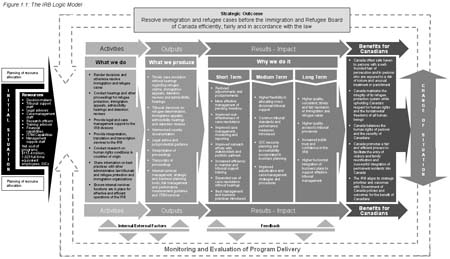
(Click on image to enlarge)
Organizational Information
Chairperson
The Chairperson is the IRB's Chief Executive Officer, senior decision-maker and spokesperson. Providing overall leadership and direction to the IRB's three decision-making divisions, the Chairperson is responsible for creating and promoting a vision of the IRB that unifies all IRB personnel around the common purpose of resolving immigration and refugee cases, as early as possible in the process, while maintaining fairness and quality.
Executive Director
The Executive Director is the IRB's Chief Operating Officer and reports to the IRB Chairperson. The Executive Director is responsible for IRB operations and the administration of the IRB's three decision-making divisions.
The Executive Director is responsible for the complement of public service employees, including those who provide direct support to the IRB's decision-making activities. This position is currently vacant pending decisions on IRB governance.
Senior Management
Two Deputy Chairpersons (appointed by the Governor in Council) and one Director General (appointed under the Public Service Employment Act) oversee decision-making in the three divisions. Four Directors General and a Senior General Counsel (all appointed under the Public Service Employment Act) are responsible for the IRB's operations, legal services and corporate management and services functions.
Organizational Chart
Figure 1.2: IRB Organizational Chart
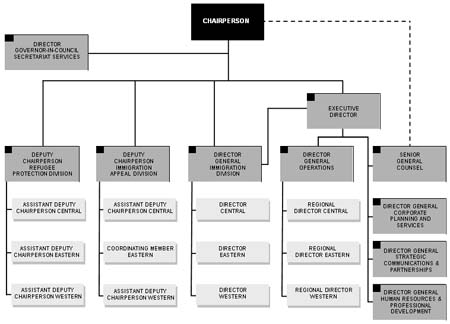
(Click on image to enlarge)
Program Activity Architecture Crosswalk
The 2006 Budget called for a renewal of the Government's Expenditure Management System (EMS) with the aim of ensuring that federal programs focus on results, deliver value for money, are consistent with federal priorities and continue to serve the purposes for which they were created. The Treasury Board Secretariat (TBS) has indicated that full implementation of its Management, Resources and Results Structure (MRRS) Policy is an essential element of a renewed EMS for the Government of Canada.
As part of this implementation process, the IRB received approval from the TBS in 2007-2008 to amend its Program Activity Architecture (PAA). Specifically, the descriptions of the IRB's strategic outcome and program activities were updated whereby the sub-program and sub sub-program activities were rolled up into their respective, higher-level program activities (see Figure 1.3).
The end result is a more streamlined and efficient PAA that fully complies with the MRRS Policy. In 2008-2009, the IRB will finalize its MRRS performance measurement framework and governance structure, which will complete the IRB's implementation of the MRRS Policy.
This Report on Plans and Priorities (RPP) is based on the IRB's amended PAA. There is no redistribution of financial resources. The IRB's work continues to be conducted through three program activities and internal services. The three program activities are responsible for all tribunal decisions and resolutions made at the IRB and internal services is responsible for the IRB's corporate management services that support the IRB's program activities (see Figure 1.4).
Figure 1.3: The IRB Program Activity Architecture Crosswalk
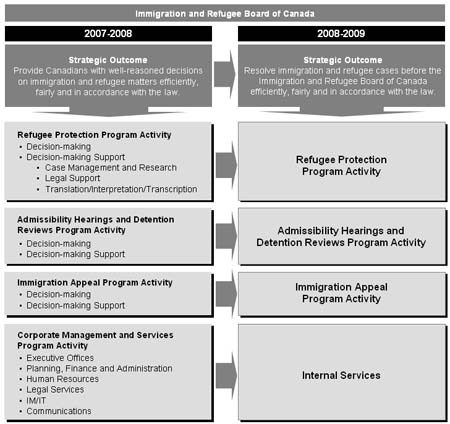
(Click on image to enlarge)
Descriptions of the IRB's amended program activities and internal services are presented in the figure below.
Figure 1.4: The 2008-2009 IRB Program Activity Architecture Descriptions
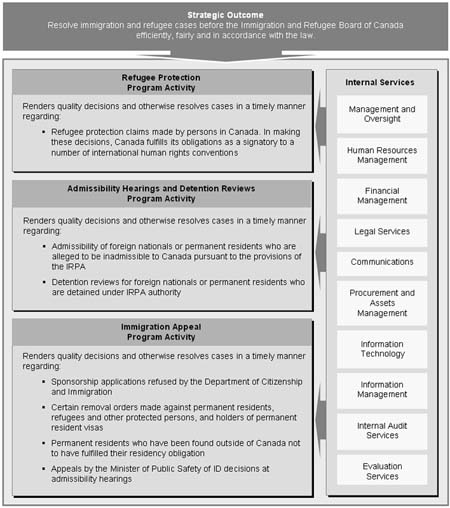
(Click on image to enlarge)
Voted and Statutory Items
The table below shows how Parliament votes resources to the IRB and largely replicates the summary table displayed in the Main Estimates. Resources are presented to Parliament in this format. Parliament approves the voted funding and the statutory information is provided for information purposes.
Table 1.3: Voted and Statutory Items
|
2008-2009
|
($ millions)
|
||
|
Voted or Statutory Items
|
Truncated Vote of
Statutory Wording |
2008-2009
Main Estimates |
2007-2008
Main Estimates |
|
10
|
Program expenditures
|
100.6 | 100.3 |
|
(S)
|
Contributions to
employee benefit plans |
12.8 | 13.4 |
|
Total
|
113.4 | 113.7 | |
Planned Spending and Full-Time Equivalents
The following table summarizes the Main Estimates and presents the IRB's total planned spending requirements for 2008-2009, 2009-2010 and 2010-2011.
Table 1.4: Planned Spending and Full-time Equivalents (FTEs)
|
|
($ millions)
|
|||
|
Forecast Spending 2007-2008
|
Planned Spending 2008-2009
|
Planned Spending 2009-2010
|
Planned Spending 2010-2011
|
|
|
Refugee Protection
|
85.5 | 80.8 | 80.6 | 80.6 |
|
Admissibility Hearings and Detention Reviews
|
15.2 | 15.2 | 15.2 | 15.2 |
|
Immigration Appeal
|
13.0 | 17.4 | 17.4 | 17.4 |
|
Budgetary Main Estimates (gross)
|
113.7 | 113.4 | 113.2 | 113.2 |
|
Less: Respendable revenue
|
||||
|
Total Main Estimates
|
113.7 | 113.4 | 113.2 | 113.2 |
|
Adjustments:
|
||||
|
Supplementary Estimates
|
||||
|
Funding for activities that are essential to the continued implementation of the Public Service Modernization Act
|
0.1 | |||
|
Other
|
||||
|
Operating budget carry forward (Treasury Board Vote 22)
|
4.6 | |||
|
Compensation adjustments (Treasury Board Vote 15)
|
0.7 | |||
|
Incremental funding for internal audit (Treasury Board Vote 10)
|
0.1 | |||
|
Employee Benefit Plan (EBP)
|
0.2 | |||
|
Total Adjustments
|
5.7 | |||
|
Total Planned Spending
|
119.4 | 113.4 | 113.2 | 113.2 |
|
Plus: Cost of services received without charge
|
19.6 | 19.6 | 19.6 | 19.6 |
|
Total Spending
|
139.0 | 133.0 | 132.8 | 132.8 |
|
Full-time Equivalents (FTEs)
|
1,025 | 1,025 | 1,025 | 1,025 |
The variance between the 2007-2008 Forecast Spending and Planned Spending in 2008-2009 is a decrease of $6.0 million. This decrease is mainly due to:
- The operating budget carry forward for 2006-2007 of $4.6 million;
- A decrease of $0.7 million from the Cost Efficiency Savings Reduction; and
- A decrease of $0.7 million to adjust the EBP factor from 18.5% to 17.5%.
Summary Information
Total Financial and Human Resources
The IRB's three-year forecast for its total financial and human resources is presented below.
Table 1.5: Total Financial and Human Resources Requirements for 2008-2009, 2009-2010 and 2010-2011
| Financial Resources ($ millions) | ||
| 2008-2009 | 2009-2010 | 2010-2011 |
| 113.4 | 113.2 | 113.2 |
| Human Resources (Full-time Equivalents) | ||
| 2008-2009 | 2009-2010 | 2010-2011 |
| 1,025 | 1,025 | 1,025 |
IRB Strategic Outcome and Strategic Priorities
This section provides information at the organizational level on the IRB's strategic outcome, strategic priorities and program activities by strategic outcome.
IRB Strategic Outcome
Based on its legislated mandate, the IRB's single strategic outcome (as amended for 2008-2009) is as follows:
Resolve immigration and refugee cases before the Immigration and Refugee Board of Canada efficiently, fairly and in accordance with the law.
IRB Strategic Priorities
To achieve its strategic outcome, the IRB has identified three strategic priorities for 2008-2009. These contribute to the achievement of the IRB's strategic outcome by ensuring that the IRB's plans, activities and expected results emphasize quality, consistency and efficiency across the organization, foster an open environment that values its people, and promote flexibility, accountability and continuous improvement.
Table 1.6: IRB Strategic Priorities for 2008-2009
| STRATEGIC OUTCOME: Resolve immigration and refugee cases before the Immigration and Refugee Board of Canada efficiently, fairly and in accordance with the law. | |
| 2008-2009 STRATEGIC PRIORITIES | |
| 1. Manage the case inventory through innovative adjudicative and case management strategies. | Ongoing |
| 2. Further integrate the work of the IRB to promote effective management. | Previously committed to |
| 3. Continue to build a flexible organization with clear accountabilities, ethical behaviour, leadership and operational capacity. | Previously committed to |
IRB Program Activities by Strategic Outcome
The following table presents the IRB's strategic outcome, supporting program activities, the overall expected result for each program activity (as per the IRB's amended PAA) and the planned spending for each program activity.
Table 1.7: IRB Program Activities by Strategic Outcome
| Program Activities by Strategic Outcome | ($ millions) | ||||
| Expected Results | Planned Spending | ||||
| 2008-2009 | 2009-2010 | 2010-2011 | |||
| STRATEGIC OUTCOME: Resolve immigration and refugee cases before the Immigration and Refugee Board of Canada efficiently, fairly and in accordance with the law. | The IRB's three strategic priorities support the IRB's strategic outcome. | ||||
| Refugee Protection Program Activity | Quality decisions rendered and cases resolved in a timely manner regarding refugee protection claims made in Canada. | 80.8 | 80.6 | 80.6 | |
| Admissibility Hearings and Detention Reviews Program Activity | Quality decisions rendered and cases resolved in a timely manner regarding admissibility hearings and detention reviews. | 15.2 | 15.2 | 15.2 | |
| Immigration Appeal Program Activity | Quality decisions rendered and cases resolved in a timely manner regarding immigration appeals. | 17.4 | 17.4 | 17.4 | |
Note: The total Internal Services planned spending per year is $28.0 million and includes $17.6 million for personnel, $3.1 million for the EBP and $7.3 million for other operating expenditures. The amount of $28.0 million is proportionally reallocated to the IRB's program activities: $19.9 million to Refugee Protection, $3.8 million to Admissibility Hearings and Detention Reviews and $4.3 million to Immigration Appeal. The reallocation is based on respective budget expenditure trends.
IRB Plans and Priorities
The IRB develops an Integrated Business Plan (IBP) for each fiscal year. In the IBP, program and management priorities (i.e., the IRB's strategic priorities) are established along with supporting plans and expected results for each program activity.
The IRB's 2008-2009 IBP is aligned with the stated plans and priorities of this RPP and will be monitored for progress and performance through senior management reviews. In 2008-2009, efforts will continue to integrate common procedural, adjudicative and administrative activities across the organization and to identify ways to improve productivity and value for money in the organization, which contribute directly to achieving better results for Canadians.
Program and management plans and priorities for the organization are presented in Sections 2 and 4.
Operating Environment
The IRB carries out its mandate within a complex and ever-changing environment. Both international and domestic factors can influence the IRB's operating environment and context. For example, conflicts and country conditions abroad can result in refugee movements, which in turn affect the number of refugee protection claims made in Canada. The same is true of unanticipated shifts in international migration patterns, which can affect the number of people seeking admission to Canada.
Refugee Populations
The 2006 Global Trends report, published by the United Nations High Commissioner for Refugees (UNHCR), shows that there were an estimated 9.9 million refugees by the second quarter of 2006. Furthermore, according to recent figures (January to September 2007) from the Intergovernmental Consultations on Asylum, Refugee and Migration Policies, the number of claims for refugee protection made in many industrialized nations has continued to decline.
Figure 1.5: Refugee Claims Filed (2003-2007)
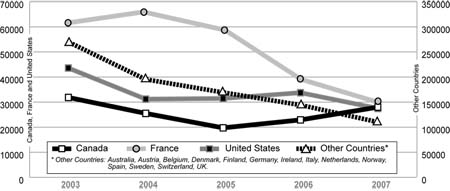
(Click on image to enlarge)
In Canada, however, the increase in refugee protection claims seen in 2006 continued into 2007 with Mexico, Colombia and Haiti representing the top source countries for refugee protection claims. The Americas account for well over half of all claims referred and Mexico continues to comprise an increasing portion of all IRB referrals at nearly 25 percent.
In 2008-2009, Mexico, Haiti, Colombia and China are expected to be the top source countries for refugee protection claims in Canada. This is due to a number of factors, including political polarization and slow or stagnant economic growth in parts of Latin America, shifting American asylum policies and political unrest in Asia.
Changing Workloads
In light of the changing workloads due to the increased numbers of refugee protection claims and immigration appeals, the IRB is increasing its emphasis on an integrated approach to the management and processing of all of its cases. Cases are becoming more complex, driven by mixed migration, broader grounds for protection, security concerns and fraudulent documentation.
Growing Trend of Family Sponsorships
Immigration continues to be very important for Canada, as immigrants represent an increasing part of the population. Canada's population of immigrants is expected to reach between 7 and 9.3 million by 2017. In this context and given the Government of Canada's priority of promoting family reunification, family-class sponsorship applications have increased at Canadian visa posts around the world. As a result, the IRB will continue to experience a growing number of family sponsorship appeals.
Refugee Appeal Division
As a result of the tabling of Bill C-280, which calls for the implementation of the Refugee Appeal Division (RAD), the IRB and its portfolio partners CIC and the Canada Border Services Agency (CBSA) are carrying out preliminary work to determine the implementation plan for the RAD in the event that Bill C-280 comes into force. There are many challenges associated with the uncertainty of the legislative result of Bill C-280. This includes the availability of funding to support the RAD, the impact that the RAD will have on the IRB in light of the RPD's increasing inventory and the current shortfall in the decision-maker complement.
Safe Third Country Agreement
The Safe Third Country Agreement has been in effect between the United States and Canada since 2005. Under that agreement, refugee protection claimants who travel through the United States or Canada, with some exceptions, are required to make their claims in the country where they first arrived. The IRB is closely monitoring the litigation surrounding this agreement as a change in the agreement or its legal status could have an impact on the numbers of refugee claims referred to the RPD as well as the distribution of those claims across the country.
Accountability
Public interest in the IRB's work continues, along with a greater demand for accountability and transparency in government. In December 2006, the Government of Canada brought into force the Federal Accountability Act (FAA). As noted in the April 2006 Speech from the Throne, this Act changes the existing system of oversight and management by strengthening the rules and institutions that ensure transparency and accountability to Canadians. The IRB continues to respond to this demand by improving performance reporting and implementing modern management practices (e.g., risk management and core management controls). Furthermore, the IRB is strengthening its management accountability in the areas identified for further progress in Round IV of the TBS Management Accountability Framework (MAF) Assessments.
Government-wide initiatives
The IRB continues to implement government-wide initiatives aimed at improving public sector management and management practices in order to enhance the organization's overall performance. In 2008-2009, initiatives will include the full implementation of the Government of Canada's MRRS Policy and the development of procurement and assets management policies and directives. The IRB will also continue to modernize its HR management practices and implement further initiatives related to the renewal of the public service and employment equity. These measures support the IRB's efforts to build the requisite management and organizational capacity to sustain a high volume of resolutions and decisions by ensuring that the necessary infrastructure and best management practices are in place.
Code of Conduct and Protocol Addressing GIC Decision-maker Conduct Issues
The IRB will adopt a new Code of Conduct over the next fiscal year, applicable to all quasi-judicial decision-makers at the IRB, to make it more comprehensive and consistent with the FAA. The IRB was the first federal administrative tribunal to institute a formal process for addressing complaints about the conduct of GIC-appointed decision-makers. The Protocol Addressing Member Conduct Issues instituted in October 1999 recognizes that high standards of conduct are required of public officials, such as IRB decision-makers. This protocol will undergo a thorough revision in 2008-2009.
GIC Decision-maker Recruitment and Selection Process
Canadians expect high levels of competence and ethical conduct from those who hold public office. A merit-based approach for the selection and appointment of public officials in government is an important way for federal institutions to promote public confidence.
In 2008-2009, the IRB will further implement a strengthened merit-based GIC decision-maker selection process, which bolsters the competency focus of the IRB selection process while increasing transparency and fairness. Under the revised selection process, the new Selection Advisory Board (SAB) reviews the candidates' qualifications, which are measured against a high standard of competence to ensure that skills, abilities and personal suitability are the basis for the appointment. All current GIC decision-makers have been and will continue to be appraised against the competency standards.
In the next fiscal year, the IRB will continue to conduct regular and focused recruitment campaigns to ensure that the Chairperson is able to provide the Minister with recommendations on a sufficient number of qualified candidates who have successfully completed the rigorous SAB process. Particular efforts will be made to ensure that candidates who can conduct hearings in both official languages are recommended for all regions. These campaigns build on the intensive decision-maker recruitment efforts initiated in mid-2007 and were ongoing at the end of March 2008.
Portfolio Management
As partners within the immigration and refugee portfolio, the IRB, CIC and the CBSA collaborate on operational matters while respecting each other's distinct mandates and the IRB's independence (see Figure 1.6). The portfolio approach has created opportunities for effective communication and coordination. Relationships within the portfolio reflect strengthened efforts in this regard on issues relating to the overall management of the portfolio and take into account evolving case management initiatives designed to meet ongoing challenges.
The IRB, CIC and the CBSA are currently negotiating a trilateral Memorandum of Understanding (MOU) which will more clearly define their institutional relationships and reflect the current operational environment and priorities. The agreement is expected to be signed in 2008-2009. This MOU will build on the IRB and CIC Administrative Framework Agreement, which has been in place since December 1996. It defines the administrative relationship between the two organizations while underlining the institutional independence of the IRB and its decision-makers.
Figure 1.6: The IRB, CIC and CBSA Portfolio
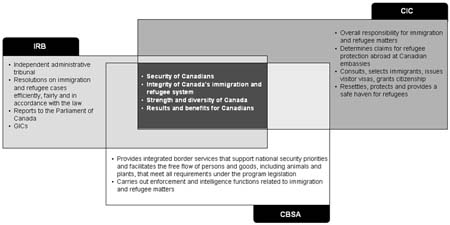
(Click on image to enlarge)
Partners and Agencies
The IRB continues to work closely with central agencies, including the Privy Council Office on GIC appointments of IRB decision-makers and on regulatory initiatives and the TBS on program management and accountability. The IRB also works with Public Works and Government Services Canada on procurement and accommodation issues and with the Public Service Commission, the Canada Public Service Agency and the Canada School of Public Service on HR management issues. In addition, the IRB will play a leading role in the organization of the 2008 conference of the Council of Canadian Administrative Tribunals, of which the Chairperson is co-chair. Conferences such as this provide an opportunity for Canadian administrative tribunals to share best practices and new approaches to emerging issues.
Stakeholders
The IRB's Consultative Committee on Practices and Procedures (CCPP) encourages systematic and regular contact between the IRB and non-governmental stakeholders at the national level. The Committee is composed of representatives from the Canadian Council for Refugees, the Canadian Bar Association, the Refugee Lawyers Association, L'Association québécoise des avocats et des avocates en droit de l'immigration, the Canadian Association of Professional Immigration Consultants and the UNHCR. The CCPP provides a forum for consultation, advice, information sharing and the discussion of issues of mutual concern regarding procedures and practices.
IRB regional offices maintain relationships with their own regional stakeholders, including immigration consultants and bar associations, refugee and refugee law associations, UNHCR regional representatives and non-governmental organizations.
In an effort to further enhance its interaction with stakeholders, the IRB is examining how it coordinates consultations to improve the way by which the regional offices and headquarters share this information. As part of this exercise, the IRB will be proposing some adjustments to the CCPP and will introduce a new consultative framework to improve its consultative activities and better manage its relationships with stakeholders.
International Context
Refugee protection transcends national borders. The IRB has established an international reputation for expertise in refugee determination. Consistent with our mandate and resources, the IRB maintains an active international presence in three main areas.
- Participation in specialized multilateral fora: the IRB regularly participates in the International Association of Refugee Law Judges, the UNHCR Executive Committee, the Intergovernmental Consultations on Migration, Asylum and Refugees and the European Union Network for Asylum Practitioners.
- Bilateral intergovernmental relations: the IRB exchanges information and practices with a number of other refugee-receiving countries, including, Australia, Germany, Japan, the Republic of Korea, the Netherlands, New Zealand, Sweden, the United Kingdom and the United States of America.
- Transfer of expertise/capacity-building partnerships: the IRB is involved in a multi-faceted partnership with the UNHCR whereby IRB personnel provide training and guidance on refugee status determination to UNHCR field staff. Discussions are also taking place on the possibility of expanding this partnership to capacity-building initiatives involving nascent national refugee authorities.
Section 2: Analysis of Program Activities by Strategic Outcome
This section provides detailed information on the plans and expected results and financial and human resources for the IRB's three program activities.
Common Elements
As noted in Section 1, the IRB prepares an IBP. The RPP and the Departmental Performance Report (DPR) are based on the plans and expected results presented in this annual plan.
A key part of the IRB's RPP, DPR and IBP is the identification of the plans and expected results of initiatives that are of common interest to the three program activities. The three program activities will work together to achieve these plans and expected results, which directly support the achievement of the IRB's 2008-2009 strategic priorities and strategic outcome.
Table 2.1: Common Elements in the IRB's Plans and Expected Results
| STRATEGIC OUTCOME: Resolve immigration and refugee cases before the Immigration and Refugee Board of Canada efficiently, fairly and in accordance with the law. | |
| STRATEGIC PRIORITY 1 Manage the case inventory through innovative adjudicative and case management strategies. |
|
| Plans | Expected Results |
| Integrated Case Management System (ICMS) | |
| Continued Implementation of ICMS | |
| ICMS Transition from the System for Tracking and Refugees (STAR) | |
| ICMS Maintenance: Identify and implement system enhancements through consultation and decision-making with the client (regions) |
|
| ICMS Caseload: Provide support to the regional operations to ensure processing of the RPD caseload in ICMS |
|
| ICMS Reporting: Review reporting mechanisms to support senior management decision-making and operational case management |
|
| ICMS | |
| ICMS Training | |
| Deliver system training/re-training to public service employees and decision-makers across the country via the ICMS training network, coaching/mentoring, e-learning modules, new decision-maker training, mock hearing room and/or classroom training |
|
| ICMS Modules | |
| Initiate consultations to map the business process and develop business requirements for the ID |
|
| Develop the National Reasons Database |
|
| Develop a framework for the use of videoconferencing and new technology across the divisions |
|
| Hearing readiness: take pre-hearing action to ensure that files are hearing-ready and to facilitate a proactive hearing |
|
| Evaluate the revised ID-IAD streamlining process and consider expansion to other regions |
|
| ID-IAD implementation of new legislation with respect to s. 86 in accordance with the law |
|
Deliver focused training on priority topics in order to:
|
|
| Liaise with Canada's administrative justice community and international partners in order to benefit from their experiences and best practices in the area of adjudicative and case management initiatives |
|
| STRATEGIC PRIORITY 2 Further integrate the work of the IRB to promote effective management. |
|
| Plans | Expected Results |
| Evaluate the IAD-RPD Western Region Integration pilot project and consider expansion to other regions |
|
| Develop a common approach to reducing adjournments/postponements across the divisions |
|
| STRATEGIC PRIORITY 3 Continue to build a flexible organization with clear accountabilities, ethical behaviour, leadership and operational capacity. |
|
| Plans | Expected Results |
| Implement an action plan further to the recommendations of the Roles and Responsibilities Review |
|
| Implement the revised IRB Code of Conduct for all decision-makers |
|
| Revise the complaint protocol and process for GIC decision-makers |
|
| Pursue recruitment efforts of GIC decision-makers for the RPD and the IAD |
|
| Put resource planning in place to ensure that the IRB has the necessary complement of decision-makers and the necessary support for new decision-makers throughout their integration |
|
| Review and update accountability profiles for GIC decision-makers and develop guidelines on the application of GIC terms and conditions of employment |
|
Distinct Program Activity Elements
The IRB's IBP also identifies the plans, expected results and operations that are distinct to each IRB program activity and contribute to achieving the IRB's strategic priorities for 2008-2009 and the IRB's strategic outcome. These are highlighted in the following detailed analyses; the detailed analysis for Internal Services is presented in Section 4.
Refugee Protection Program Activity
| The Refugee Protection program activity receives the majority of IRB resources and is focused on rendering quality and timely decisions on inland refugee protection claims. To deliver on this mandate, the Refugee Protection program activity depends on experienced decision-makers and adjudicative support. |
Total Planned Financial and Human Resources
Table 2.2: Refugee Protection Program Activity Total Planned Financial and Human Resources
| Financial Resources ($ millions) | ||
| 2008-2009 | 2009-2010 | 2010-2011 |
| 80.8 | 80.6 | 80.6 |
| Human Resources (FTEs) | ||
| 2008-2009 | 2009-2010 | 2010-2011 |
| 780 | 780 | 780 |
2008-2009 Outlook
The deficit of decision-makers in the Refugee Protection program activity continues. Throughout much of 2007-2008, the Refugee Protection program activity experienced an average shortfall of 36 percent in decision-makers. It is likely that a significant shortage will remain in 2008-2009 with 32 decision-makers reaching the end of their terms during the next fiscal year.
The growing deficit of decision-makers has a direct impact on the IRB's ability to render fast and fair decisions. Approximately six months of training and experience is required for a new decision-maker to become fully productive, i.e., to finalize refugee claim decisions.
Despite the number of challenges that the Refugee Protection program activity faces in the next fiscal year, it will continue to enhance its decision-making process. The Refugee Protection program activity remains committed to maintaining the high standard of decision-making that has earned its refugee determination process international recognition as one of the best in the world.
Key Plans and Expected Results
The Refugee Protection program activity will benefit from the expected results of the common elements identified in Table 2.1 to achieve its forecasts for 2008-2009. In addition to its contribution to the realization of the common elements, the Refugee Protection program activity will also undertake the plans and expected results outlined in the following table.
Table 2.4: Refugee Protection Program Activity Plans and Expected Results
| STRATEGIC OUTCOME: Resolve immigration and refugee cases before the Immigration and Refugee Board of Canada efficiently, fairly and in accordance with the law. | |
| STRATEGIC PRIORITY 1 Manage the case inventory through innovative adjudicative and case management strategies. |
|
| Plans | Expected Results |
| Implement a case management strategy to minimize the growing backlog of pending claims |
|
| Develop and implement an adjudicative strategy to ensure quality and efficiency of decision-making |
|
| Evaluate the RPD Language Analysis Pilot Project and present results to the Policy Advisory Committee |
|
| Develop the next steps for the Early Information Gathering (EIG) initiative |
|
| Improve the National Documentation Packages (NDPs) |
|
Outputs
The 2008-2009 outputs for the Refugee Protection program activity are as follows:
- Claims referred
- Claims finalized
- Claims pending
- Average processing time
- Average cost per claim finalized
Claims referred
Based on current trends, the Refugee Protection program activity expects that it will receive approximately 36,000 new claims in 2008-2009, 20 percent more than in 2007-2008.
Figure 2.1: Refugee Protection Claims Referred

(Click on image to enlarge)
Note: The numbers have been rounded off to the nearest hundred.
Claims finalized
Despite the significant shortage of decision-makers, the Refugee Protection program activity expects to finalize approximately 16,000 claims in 2008-2009, 14 percent more than in 2007-2008. This is due in part to continued enhancements in the decision-making process.
Figure 2.2: Refugee Protection Claims Finalized

(Click on image to enlarge)
Note: The numbers have been rounded off to the nearest hundred.
Claims pending
The significant decrease in decision-makers and unexpected influx of claims in 2007-2008 resulted in a pending inventory of approximately 42,300 claims; an amount that will increase in the next fiscal year without the required decision-makers. As a result, it is projected that the pending inventory could exceed 60,000 claims by the end of 2008-2009. Even with new appointments, this number will increase due in part to the time required to train new decision-makers.
Figure 2.3: Refugee Protection Claims Pending

Note: The numbers have been rounded off to the nearest hundred.
Average processing time
Based on the expectation that the Refugee Protection program activity will have a pending inventory of 62,300 claims in 2008-2009, the time required to finalize a claim will increase, and it may take on average 16.5 months to process a claim (from referral to finalization) in 2008-2009.
Average cost per claim finalized
Based on 16,000 claim finalizations, the average forecasted cost per claim is expected to be $4,700 for 2008-2009. The forecasted average cost per claim is higher than the 2006-2007 actual average cost of $4,117. The increase for 2008-2009 is attributable to several factors, including a higher share of fixed costs per unit caused by a decrease in the projected volume of claim finalizations and increased salary costs.
The cost per claim includes the decision-making costs and costs of related activities such as case preparation, research, scheduling of hearings, legal services, foreign-language interpretation, technological support, translation services and administrative support. It also includes a share of the costs from Internal Services, which is allocated to the three program activities, based on expenditure trends.
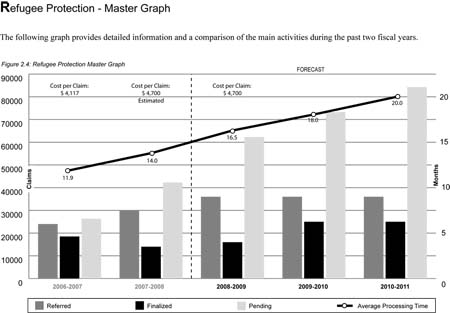
(Click on image to enlarge)
Admissibility Hearings and Detention Reviews Program Activity
| The Admissibility Hearings and Detention Reviews program activity holds hearings for foreign nationals or permanent residents who are alleged to be inadmissible to Canada pursuant to the provisions of the IRPA. Detention reviews are held concerning permanent residents and foreign nationals who are detained under the IRPA authority. Detainees must be seen by the Immigration Division within 48 hours and subsequent reviews must be conducted within specific timeframes as set out in the IRPA. Decision-makers must balance the rights of individuals to liberty with the security interests of Canadians and persons in Canada. |
Total Planned Financial and Human Resources
Table 2.5: Admissibility Hearings and Detention Reviews Program Activity Planned Financial and Human Resources
| Financial Resources ($ millions) | ||
| 2008-2009 | 2009-2010 | 2010-2011 |
| 15.2 | 15.2 | 15.2 |
| Human Resources (FTEs) | ||
| 2008-2009 | 2009-2010 | 2010-2011 |
| 105 | 105 | 105 |
2008-2009 Outlook
The number of admissibility hearings and detention reviews conducted by the IRB directly depends on the number of cases referred to it by the CBSA and CIC. In 2008-2009, the Admissibility Hearings and Detention Reviews program activity will continue to experience a moderate increase in referrals for admissibility hearings, while the number of detention reviews is expected to remain stable.
Key Plans and Expected Results
The Admissibility Hearings and Detention Reviews program activity will benefit significantly from the expected results of the common elements identified in Table 2.1 to achieve its forecasts for 2008-2009. In addition to its contribution to the realization of the common elements, the Admissibility Hearings and Detention Reviews program activity will undertake the plans and expected results outlined in the following table.
Table 2.7: Admissibility Hearings and Detention Reviews Program Activity Plans and Expected Results
| STRATEGIC OUTCOME: Resolve immigration and refugee cases before the Immigration and Refugee Board of Canada efficiently, fairly and in accordance with the law. | |
| STRATEGIC PRIORITY 1 Manage the case inventory through innovative adjudicative and case management strategies. |
|
| Plans | Expected Results |
Continue to implement a strategic approach to quality decision-making by:
|
|
Pursue cross-regional consistency efforts within the ID by:
|
|
Outputs
The 2008-2009 outputs for the Admissibility Hearings and Detention Reviews program activity are as follows:
- Admissibility hearings finalized
- Detention reviews finalized
- Average cost per admissibility hearing finalized
- Average cost per detention review finalized
Admissiblity Hearings finalized
The number of referrals for admissibility hearings has increased by 11 percent over the past three years. The Admissibility Hearings and Detention Reviews program activity expects to finalize 2,500 admissibility hearings in 2008-2009 and 2,500 admissibility hearings in each of the two following fiscal years.
Figure 2.5: Admissibility Hearings Finalized

(Click on image to enlarge)
Note: The numbers have been rounded off to the nearest hundred.
Detention Reviews finalized
The number of detention reviews remains stable. The Admissibility Hearings and Detention Reviews program activity anticipates that it will finalize approximately 11,500 detention reviews in 2008-2009 and in the two following fiscal years. Ongoing challenges include the pressures associated with meeting statutory timeframes, travelling to detention facilities to conduct reviews and increased public scrutiny in balancing the rights to liberty of individuals with the security of Canadians and persons in Canada. Criminality, an important factor in detention reviews, is an element that is present in a high proportion of cases, particularly those that involve long-term detention.
Figure 2.6: Detention Reviews Finalized

(Click on image to enlarge)
Note: The numbers have been rounded off to the nearest hundred.
Average cost per admissibility hearing and detention review finalized
Based on 2,500 admissibility hearings and 11,500 detention reviews, the average forecasted cost is expected to be $1,100 and $800 respectively for 2008-2009. These forecasted average costs are in line with the 2006-2007 actual average costs of $1,133 for admissibility hearings and $751 for detention reviews.
The cost per admissibility hearing and detention review includes decision-making costs and costs of related activities such as case preparation, research, scheduling of hearings, legal services, foreign-language interpretation, technological support, translation services and administrative support. It also includes a share of the costs from Internal Services, which is allocated to the three program activities, based on expenditure trends.
Figure 2.7: Admissibility Hearings Master Graph
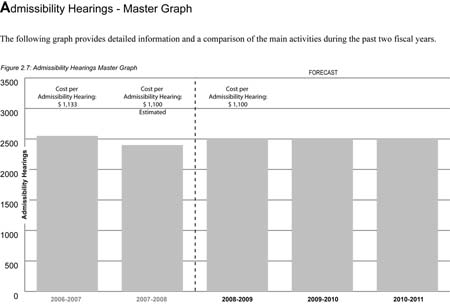
(Click on image to enlarge)
Figure 2.8: Detention Review Master Graph
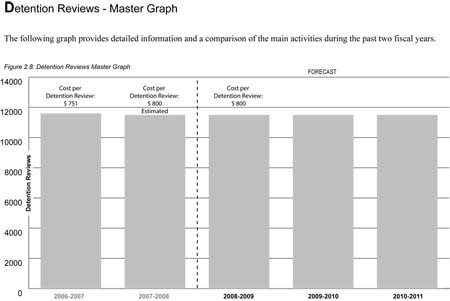
(Click on image to enlarge)
Immigration Appeal Program Activity
| The Immigration Appeal program activity hears immigration appeals from Canadian citizens and permanent residents whose applications to sponsor close family members to Canada have been refused. Other key functions include hearing appeals from permanent residents, foreign nationals with a permanent resident visa, protected persons who have been ordered removed from Canada and permanent residents outside of Canada who have not fulfilled their residency obligation. |
Total Planned Financial and Human Resources
Table 2.8: Immigration Appeal Program Activity Total Planned Financial and Human Resources
| Financial Resources ($ millions) | ||
| 2008-2009 | 2009-2010 | 2010-2011 |
| 17.4 | 17.4 | 17.4 |
| Human Resources (FTEs) | ||
| 2008-2009 | 2009-2010 | 2010-2011 |
| 140 | 140 | 140 |
2008-2009 Outlook
The shortfall in decision-makers in the Immigration Appeal program activity is expected to continue in 2008-2009. In 2007-2008, the Immigration Appeal program activity experienced an average shortfall of 31 percent in decision-makers.
Despite limited decision-maker resources in the past several years, the Immigration Appeal program activity continues to build successful procedural, adjudicative and administrative practices that increase its efficiency and productivity. However, new appointments and reappointments of decision-makers are essential for the Immigration Appeal program activity to be fully productive.
In 2008-2009, the Immigration Appeal program activity will have nine experienced decision-makers whose terms are expiring. Based on past experience, some reappointments and new appointments are anticipated. However, new decision-makers, who require training and experience, will not be fully productive until halfway into their first year. As a result, even with approximately the same level of decision-maker's, the full positive impact of new decision-makers will not be seen until later years.
Key Plans and Expected Results
The Immigration Appeal program activity will benefit from the expected results of the common elements identified in Table 2.1 to achieve its forecasts for 2008-2009. In addition to its contribution to the realization of the common elements, the Immigration Appeal program activity will undertake the plans and expected results outlined in the following table.
Table 2.10: Immigration Appeal Program Activity Plans and Expected Results
| STRATEGIC OUTCOME: Resolve immigration and refugee cases before the Immigration and Refugee Board of Canada efficiently, fairly and in accordance with the law. | |
| STRATEGIC PRIORITY 1 Manage the case inventory through innovative adjudicative and case management strategies. |
|
| Plans | Expected Results |
| Implement an inter-regional case inventory management plan, including continuation of the Central Region IAD backlog reduction plan |
|
Develop and implement adjudicative strategies to enhance consistency in decision-making. Areas may include:
|
|
| Increase the early resolution of appeals without a hearing: evaluate and improve EIR and ADR |
|
| Assess the effectiveness of initiatives and case streams implemented under IAD Innovation |
|
Outputs
The 2008-2009 outputs for the Immigration Appeal program activity are as follows:
- Appeals filed
- Appeals finalized
- Appeals pending
- Average processing time
- Average cost per appeal finalized
Appeals filed
The Immigration Appeal program activity anticipates 7,500 appeals will be filed in 2008-2009, which is a continuation of the moderate increases seen in the past few years. The increased intake is primarily a result of the increase in sponsorship appeals. The overall level of the intake is expected to continue to grow in 2008-2009 and 2009-2010 and remain high in subsequent years.
Figure 2.9: Immigration Appeals Filed

(Click on image to enlarge)
Note: The numbers have been rounded off to the nearest hundred.
Appeals finalized
The Immigration Appeal program activity expects to finalize approximately 5,800 appeals in 2008-2009; only three percent less than in 2007-2008. Despite the shortage of decision-makers, the Immigration Appeal program activity experienced only a small decrease in productivity due in part to continued enhancements in its innovative case processing. In later years, if the Immigration Appeal program activity can increase its decision-makers to a full complement, it will begin to reduce the large pending inventory and the average case processing times.
Figure 2.10: Immigration Appeals Finalized

(Click on image to enlarge)
Note: The numbers have been rounded off to the nearest hundred.
Appeals pending
The unexpected increase in appeals filed, together with the significant decrease in decision-makers in 2007-2008, particularly in the Western and Central Regions, resulted in a pending inventory of approximately 10,400 appeals at the end of the fiscal year. Without the required complement of decision-makers, this amount will increase in 2008-2009. As a result, it is projected that the pending inventory could exceed 12,000 appeals by the end of 2008-2009. Even with new appointments, the number may increase due in part to the time required to train new decision-makers.
Figure 2.11: Immigration Appeals Pending

(Click on image to enlarge)
Note: The numbers have been rounded off to the nearest hundred.
Average processing time
The average processing time is expected to increase to approximately 10.5 months in 2008-2009.
Average cost per appeal finalized
Based on 5,800 appeal finalizations, the forecasted average cost per appeal is expected to be $3,000 for 2008-2009. The average forecasted cost per appeal is higher than the 2006-2007 actual average cost of $2,260 per appeal. The increase for 2008-2009 is attributable to several factors, including a higher share of fixed costs per unit caused by a slight decrease in the projected volume of appeal finalizations, increased adjudicative support and increased salary costs.
The cost per appeal includes the decision-making costs and costs of related activities such as case preparation, research, scheduling of hearings, legal services, foreign-language interpretation, technological support, translation services and administrative support. It also includes a share of the costs from Internal Services, which is allocated to the three program activities, based on expenditure trends.
Figure 2.12: Immigration Appeal Master Graph
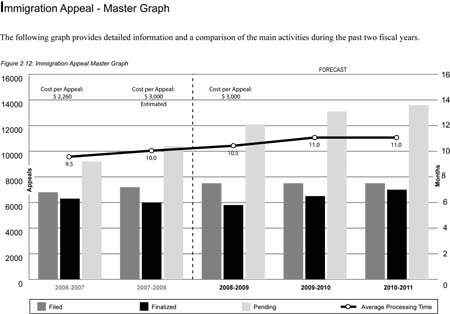
(Click on image to enlarge)
Section 3: Supplementary Information
Departmental Link to Government of Canada Outcomes
The following table shows the IRB's planned spending by program activity and alignment to the Government of Canada outcome areas.
Table 3.1: Departmental Link to the Government of Canada Outcome Areas
| Departmental Link to the Government of Canada Outcomes | ||||
| STRATEGIC OUTCOME: Resolve immigration and refugee cases before the Immigration and Refugee Board of Canada efficiently, fairly and in accordance with the law. | ||||
| Program Activities | Planned Spending ($ millions) | Alignment to Government of Canada Outcome Area | ||
| 2008-2009 | 2009-2010 | 2010-2011 | ||
| Refugee Protection | 80.8 | 80.6 | 80.6 | A safe and secure world through international cooperation |
| Admissibility Hearings and Detention Reviews | 15.2 | 15.2 | 15.2 | Safe and secure communities* |
| Immigration Appeal* | 17.4 | 17.4 | 17.4 | A vibrant Canadian culture and heritage |
* Through its removal orders work, the Immigration Appeal Program Activity also contributes to the Safe and Secure Communities outcome area.
The table below outlines the contribution that each IRB program activity makes to the Government of Canada outcome areas.
Table 3.2: IRB Program Activity Contributions to Government of Canada Outcome Areas
| Contributing to the Quality of Life of Canadians |
| GOVERNMENT OF CANADA OUTCOME AREAS |
| International Affairs A Safe and Secure World through International Cooperation |
|
| Social Affairs Safe and Secure Communities |
*Through its removal orders work, the Immigration Appeal Program Activity also contributes to the Safe and Secure Communities outcome area. |
| Social Affairs A Vibrant Canadian Culture and Heritage |
|
List of Electronic Tables
The following electronic tables can be found on the Secretariat’s website at: http://www.tbs-sct.gc.ca/rpp/2008-2009/info/info-eng.asp.
Table 3.5: Services Received without Charge
Section 4: Other Items of Interest
Internal Services
Internal Services provides support to the three IRB program activities through a range of management and oversight services, HR management, financial management, legal services, communications, procurement and assets management, information technology, information management, internal audit services and evaluation services. It also provides the IRB with efficient management processes and administrative services while promoting organizational effectiveness, and implements various government-wide initiatives. In addition, Internal Services ensures that all corporate management services are integrated into the IRB's business.
The annual Internal Services planned spending for 2008-2009, 2009-2010 and 2010-2011 is $28.0 million and includes $17.6 million for personnel, $3.1 million for the EBP and $7.3 million for other operating expenditures. The amount of $28.0 million is proportionally reallocated to the IRB's program activities: $19.9 million to Refugee Protection, $3.8 million to Admissibility Hearings and Detention Reviews and $4.3 million to Immigration Appeal. The reallocation is based on respective budget expenditure trends.
Key Plans and Expected Results
Internal Services continues to implement financial and non-financial management processes (e.g., risk management and core management controls) that are aligned with the IRB's strategic outcome, program activities and ultimately support the Government's commitment to be accountable for results to Canadians.
In particular, the IRB is taking steps to address areas identified for further progress in Round IV of the TBS MAF Assessments. The IRB also continues to work towards a fuller integration of the HR planning process with a focus on succession planning and employment development programs and to respond to the many drivers of public service renewal.
In addition to its contribution to the realization of the common elements identified in Table 2.1, Internal Services will undertake the plans and expected results outlined in the following table.
Table 4.1: Internal Services Plans and Expected Results
| STRATEGIC OUTCOME: Resolve immigration and refugee cases before the Immigration and Refugee Board of Canada efficiently, fairly and in accordance with the law. | |
| STRATEGIC PRIORITY 2 Further integrate the work of the IRB to promote effective management. |
|
| Plans | Expected Results |
| Develop the MRRS Policy, the PAA and the corresponding performance measurement framework |
|
| Implement the IRB Core Management Controls Action Plan |
|
| Further integrate HR, financial and IT planning into the IRB's business planning cycles |
|
| Further implement a comprehensive Procurement and Asset Management Program |
|
| Implement a corporate consultation framework |
|
| Further focus the IRB's international activities into a cohesive program that assists the IRB in achieving its international objectives while balancing the numerous requests for international participation against available resources |
|
| STRATEGIC PRIORITY 3 Continue to build a flexible organization with clear accountabilities, ethical behaviour, leadership and operational capacity. |
|
| Plans | Expected Results |
| Further implement the three-year Employment Equity (EE) Strategy |
|
| Implement the new Official Languages Policy |
|
| Implement key Public Service Renewal activities through the consolidation of HR modernization initiatives |
|
| Develop a Values and Ethics Framework for IRB employees based on the new TBS Charter |
|
Integrated Accountability Framework
Under the FAA, the IRB Chairperson becomes the IRB's Accounting Officer. In this role, the Chairperson is accountable for responsibilities such as ensuring compliance with policies and procedures for program delivery and systems of internal control, signing the accounts and ensuring that there is adequate internal audit capacity within the IRB. In 2008-2009, the IRB will continue to implement the Integrated Accountability Framework through the IRB's core management controls and the implementation of the Policy on Internal Audit.
Figure 4.1: IRB Integrated Accountability Framework
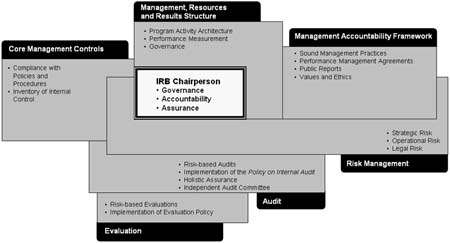
Information and Contacts
Legislation Administered
Immigration and Refugee Protection Act
(S.C. 2001, c. 27, as amended)
Immigration and Refugee Protection Regulations
(SOR/2002-227, as amended)
Refugee Protection Division Rules
(SOR/2002-228)
Immigration Division Rules
(SOR/2002-229)
Immigration Appeal Division Rules
(SOR/2002-230)
Oath or Solemn Affirmation of Office Rules
(Immigration and Refugee Board of Canada)
(SOR/2002-231)
IRB Processes
Visit these links to find out how the IRB processes its cases:
- Process for Making a Claim for Refugee Protection
http://www.irb-cisr.gc.ca/en/references/procedures/processes/rpd/rpdp_e.htm - Admissibility Hearing Process
http://www.irb-cisr.gc.ca/en/references/procedures/processes/id/ahp_e.htm - Detention Review Process
http://www.irb-cisr.gc.ca/en/references/procedures/processes/id/drp_e.htm - Sponsorship Appeal Process
http://www.irb-cisr.gc.ca/en/references/procedures/processes/iad/sap_e.htm - Removal Order Appeal Process
http://www.irb-cisr.gc.ca/en/references/procedures/processes/iad/reoap_e.htm - Residency Obligation Appeal Process
http://www.irb-cisr.gc.ca/en/references/procedures/processes/iad/resoap_e.htm
Related Information
UNHCR Web site: http://www.unhcr.org/home.html
Contact us
For more information, visit the IRB Web site at
http://www.irb-cisr.gc.ca
or contact the IRB Communications Directorate at (613) 947-0803 or one of the IRB offices listed below.
National Headquarters
Immigration and Refugee Board of Canada
Minto Place, Canada Building
344 Slater Street, 12th Floor
Ottawa, Ontario K1A 0K1
Tel: (613) 995-6486 Fax: (613) 943-1550
Regional Offices
Eastern Region
200 René Lévesque Boulevard West
Guy Favreau Complex
East Tower, Room 102
Montreal, Quebec H2Z 1X4
Tel: (514) 283-7733 Fax: (514) 283-0164
Central Region
74 Victoria Street, Suite 400
Toronto, Ontario M5C 3C7
Tel: (416) 954-1000 Fax: (416) 954-1165
Western Region
Library Square, Suite 1600
300 West Georgia Street
Vancouver, British Columbia V6B 6C9
Tel: (604) 666-5946 Fax: (604) 666-3043
Evaluations
The following table provides a list of evaluations that are currently scheduled to take place in 2008-2009. The IRB Evaluations are available at: http://www.irb-cisr.gc.ca/en/about/transparency/evaluations/index_e.htm
Table 3.3: List of Planned Evaluations
| Evaluation | Evaluation Type | Status | Expected Completion Date |
| Evaluation of Case Scheduling Processes |
Formative Evaluate the performance of case scheduling with the IRB's three divisions. The evaluation will focus on postponements and adjournments. |
In Progress | 2008-2009 |
| Follow-up to the Evaluation of Case Scheduling Processes |
Follow-up Monitor the implementation of the recommendations of the evaluation. |
Planned | 2008-2009 |
| Evaluation of ICMS | Summative Assess the effectiveness and efficiency of ICMS, which was launched in April 2007. |
Planned | 2008-2009 |
Internal Audits
The following table provides a list of internal audits that are currently scheduled to take place in 2008-2009. The IRB will continue to implement all of the elements of the Internal Audit Policy. The IRB Audits are available at: http://www.irb-cisr.gc.ca/en/about/transparency/evaluations/index_e.htm
Table 3.4: List of Planned Internal Audits
| Name of Internal Audit | Audit Type | Status | Expected Completion Date |
| Follow-up to the Audit of Contracting Practices | Follow-up Monitor implementation of the management response to the recommendations of the audit. |
In Progress | 2008-2009 |
| Audit of IRB Regional Offices | Compliance Determine the extent to which the IRB's three regional offices comply with applicable regulations, policies and procedures in administrative processes including finance, procurement, security of assets and people, staffing and adherence to official languages guidelines. |
In Progress | 2008-2009 |
| Follow-up to the Audit of IRB Regional Offices | Follow-up Monitor implementation of management response to the recommendations of the audit. |
In Progress | 2008-2009 |
Note: In 2007-2008, the IRB undertook one audit: an audit of IRB contracting practices prepared by Audit Services Canada. It determined the extent to which the IRB complied with applicable regulations, policies and procedures in contracting practices. The findings of the audit were used to introduce a series of measures to streamline internal controls in this area, which will be reported on in the 2007-2008 IRB Departmental Performance Report. The audit is available at: http://www.irb-cisr.gc.ca/en/about/transparency/audits/markets/index_e.htm
Services Received Without Charge
The following table provides information on services received without charge for 2008-2009.
Table 3.5: Services Received Without Charge
| 2008-2009 | ($ millions) |
| Accommodation provided by Public Works and Government Services Canada |
13.7 |
| Contributions covering employer's share of employees' insurance premiums and expenditures paid by TBS (excluding revolving funds) |
5.9 |
| Total services received without charge | 19.6 |